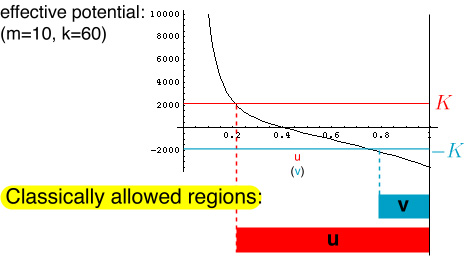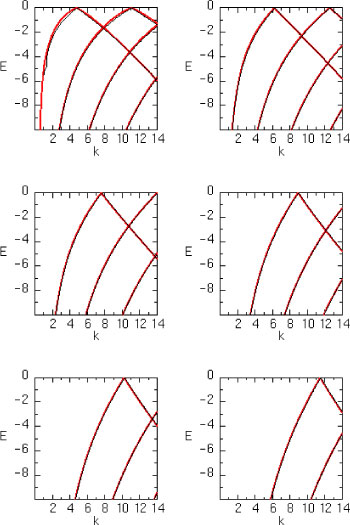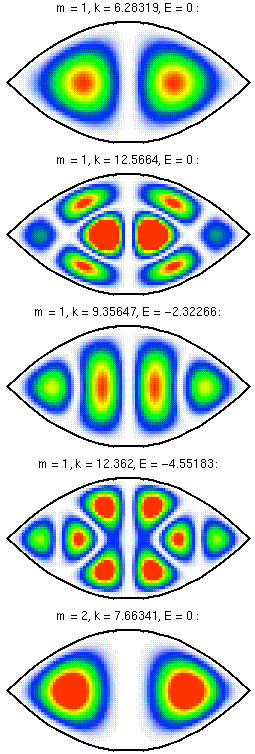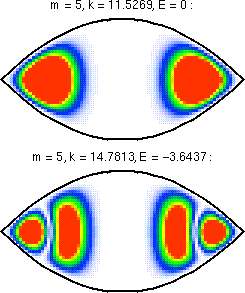






The effective potential is the same for both differential
equations (for f and g). But the "energy eigenvalue" of these
two Schrödinger-like equations are K and -K, respectively,
so that one is above and one is below zero (or both can be
zero, of course).
This is illustrated in the above potential picture with the
thin red and blue horizontal lines at +K and -K. The horizontal
axis in the plot is the coordinate u or v. The boundaries of the
double paraboloid are located at u = 1 and v = 1.
As usual for this type of differential equation, one expects high amplitude only in the classically allowed regions of the potential, i.e., where the horizontal line is higher than the potential. The resulting classically allowed ranges of the coordinates u and v are shown at the bottom as red and blue bars.
The central point about the wave equations for f and g is
the coupling of the two by way of the constants k and K. We can
make the equations look slightly simpler by putting

which leads to the equations

However, the boundary conditions are now imposed at ξ, η =
Sqrt(k).
Now we have to specify the boundary conditions. For simplicity, I will consider the typical Dirichlet boundary conditions, i.e. f and g should vanish on the paraboloid surfaces.
How to impose the boundary conditions for these coupled equations ?
The real-valued wave solutions are proportional to Kummer's
confluent hypergeometric function M,

The separation constant K (or beta) here
enters as E=K/k.
The boundary condition of vanishing wavefunction at

means that the separate roots of the equations


have to exist simultaneously.
To find these points in the k-E plane, we plot the roots of these separate equations on top of each other and look for the crossings of the curves defined by the equations.
This is done here for the lowest angular momenta m=0...5 (from top left to bottom right):

The black lines are the curves obtained from the zeros of
the equations involving the Kummer functions, the red lines are the same zeros of the corresponding
semiclassical condition.
Note the good agreement between the exact and semiclassical
zeros.
| Click on the plot to see a more exhaustive list of modes. | |
 |
k=12.14192329557385, E=-3.100689099111115 |
The correpsondence becomes better when k becomes larger. In the comparison, keep in mind that my ray plots are rotated by 90 degrees and cut in half.
Here are the symmetrized wavefunctions with even parity,
formed from the above results by using
f(ξ)*g(η)+f(η)*g(ξ).





These functions satisfy Neumann boundary conditions on the
plane ξ=η, i.e., the plane interscting the focus. This is
the actual boundary in the real dome structure, and the Neumann
boundary conditions simulate the effect of the Bragg
grating.
This page © Copyright Jens Uwe Nöckel, 06/2003
Last modified: Wed Jan 20 21:05:07 PST 2016